
Herbert Ihlefeld was a German Luftwaffe military aviator during the Spanish Civil War and World War II, a fighter ace listed with 130 enemy aircraft shot down in over 1,000 combat missions. Depending on source, he claimed seven to nine aerial victories in the Spanish Civil War, and during World War II, 67 on the Eastern Front and 56 on the Western Front, including 15 four-engined bombers and 26 Supermarine Spitfires. He survived being shot down eight times during his 1,000 combat missions.
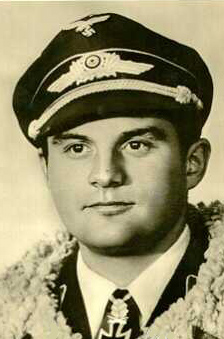
Joachim Helbig was a German bomber pilot during World War II. He joined the Luftwaffe in 1936, and served almost all of his career with Demonstration Wing 1. With his unit, he participated in the Invasion of Poland, the Norwegian Campaign, the Battles of the Netherlands, Belgium, France and Britain in 1939–40. For his contributions in these campaigns, Helbig received the Knight's Cross of the Iron Cross in late 1940. He was then transferred to the Mediterranean theater where he bombed Malta, the British Mediterranean Fleet and flew in support of the Afrika Korps. Helbig received the Knight's Cross of the Iron Cross with Oak Leaves and Swords in late 1942 for the support of Field Marshal Erwin Rommel's 1942 summer offensive.

Alfred Druschel was a German Luftwaffe combat pilot during World War II. He was a recipient of the Knight's Cross of the Iron Cross with Oak Leaves and Swords of Nazi Germany.
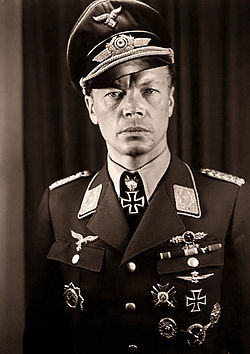
Ernst Kupfer was a ground-attack pilot in the Luftwaffe of Nazi Germany during World War II who commanded a wing of Stuka aircraft. He was a recipient of the Knight's Cross of the Iron Cross with Oak Leaves and Swords.

Major Theodor Nordmann was a World War II Luftwaffe Stuka ace. He was also a recipient of the Knight's Cross of the Iron Cross with Oak Leaves and Swords. The Knight's Cross of the Iron Cross and its higher grade Oak Leaves and Swords was awarded to recognise extreme battlefield bravery or successful military leadership.

Dietrich Peltz was a German World War II Luftwaffe bomber pilot and youngest general of the Wehrmacht. As a pilot he flew approximately 320 combat missions, including roughly 130 as a bomber pilot on the Eastern Front, 90 as a bomber pilot on the Western Front, and 102 as a dive bomber pilot during the invasion of Poland and Battle of France.

August Lambert was a German Luftwaffe military aviator and ground-attack pilot during World War II. As a fighter ace, he is credited with 116 aerial victories claimed in approximately 350 combat missions for which he was awarded the Knight's Cross of the Iron Cross, the highest award in the military and paramilitary forces of Nazi Germany during World War II. All of his aerial victories were claimed on the Eastern Front as a ground attack pilot in a Schlachtgeschwader, not as a fighter pilot in a Jagdgeschwader. He is the highest scoring ground attack pilot.

Hermann Hogeback was a German bomber pilot during the Nazi era. He flew more than 100 operational sorties during the Spanish Civil War and 500 during World War II and was a recipient of the Knight's Cross of the Iron Cross with Oak Leaves and Swords of Nazi Germany. Hogeback's last service position was commander of the 6th Bomber Wing.
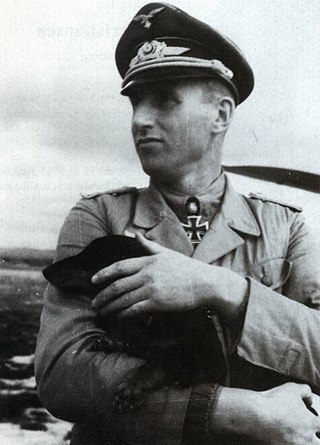
Erwin Clausen was a German Luftwaffe military aviator during World War II, a fighter ace credited with 132 aerial victories—that is, 132 aerial combat encounters resulting in the destruction of the enemy aircraft—claimed in 561 combat missions. He was "ace-in-a-day" four times, shooting down five or more aircraft on a single day.

Hans-Karl Stepp was a German ground attack pilot and wing commander during World War II. He was a recipient of the Knight's Cross of the Iron Cross with Oak Leaves, a grade of the highest award in the military and paramilitary forces of Nazi Germany during World War II.
Hermann Buchner was a former Luftwaffe fighter ace and recipient of the Knight's Cross of the Iron Cross during World War II. The Knight's Cross of the Iron Cross was awarded to recognise extreme battlefield bravery or successful military leadership. Buchner is credited with 46 tank victories and 58 aerial victories, including 12 while flying the Messerschmitt Me 262 jet fighter, accumulated in 631 combat missions.
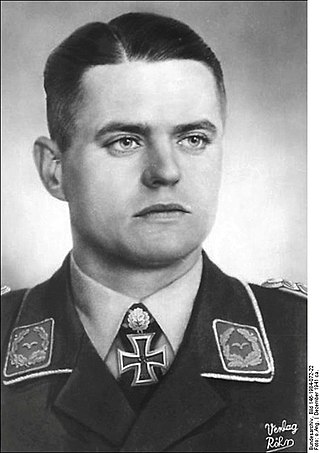
Otto Albert Bernhard Weiß was a World War II Luftwaffe attack aircraft pilot and recipient of the Knight's Cross of the Iron Cross with Oak Leaves. He was the first attack aircraft pilot so honored. Weiß flew more than 500 combat missions with the Henschel Hs 123 and the Messerschmitt Bf 109.
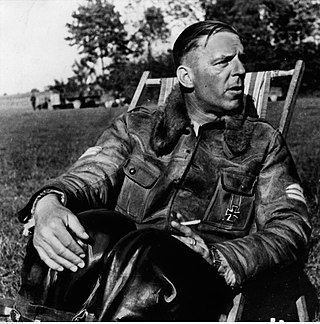
Walter Grabmann was a German general in the Luftwaffe during World War II. He was also a recipient of the Knight's Cross of the Iron Cross of Nazi Germany. Grabmann was credited with 7 aerial victories during the Spanish Civil War claimed in 137 combat missions.

Herbert Heinrich Otto Lütje was a German military aviator, a wing commander in the Luftwaffe during World War II and an officer in the postwar German Air Force. As a fighter ace, he was credited with 50 aerial victories claimed in 247 combat missions. His 47 nocturnal claims made him the twentyfourth most successful night fighter pilot in the history of aerial warfare. All of his victories were claimed in Defense of the Reich missions, the majority at night against the Royal Air Force's (RAF) Bomber Command and three daytime claims, one over a United States Army Air Forces (USAAF) Boeing B-17 Flying Fortress bomber and two Lockheed P-38 Lightning fighter aircraft.

Robert-Ludwig Becker was a German Luftwaffe military aviator during World War II, a night fighter ace credited with 44 aerial victories claimed in 165 combat missions, making him one of the more successful nocturnal fighter pilots in the Luftwaffe. All of his victories were claimed over the Western Front in Defense of the Reich missions against the Royal Air Force's (RAF) Bomber Command.

Egon Albrecht-Lemke was a German-Brazilian Luftwaffe fighter pilot and recipient of the Knight's Cross of the Iron Cross during World War II. Albrecht claimed 25 aerial victories, 10 over the Western Front and 15 over the Eastern Front.
Frank Neubert was a highly decorated Major in the Luftwaffe during World War II, and a recipient of the Knight's Cross of the Iron Cross. He is believed to have been the first victor in aerial combat in World War II after shooting down Captain Mieczyslaw Medwecki's PZL P.11 in the early hours of 1 September 1939. The Knight's Cross of the Iron Cross was awarded to recognise extreme battlefield bravery or successful military leadership. During his career he was credited with participating in 350+ missions.

Hans-Georg Schierholz was a Bordfunker and Oberfeldwebel in the Luftwaffe night fighter force during World War II. He was awarded the Knight's Cross of the Iron Cross.

Helmut Eberspächer was a German businessman and chairman of Eberspächer. During World War II, he served in the Wehrmacht as a fighter pilot. A flying ace, he was awarded the Knight's Cross of the Iron Cross, the highest award in the military and paramilitary forces of Nazi Germany during World War II. He was credited with 7 victories, each resulting in the destruction of an enemy aircraft.
Heinz Kemethmüller was a Luftwaffe ace and recipient of the Knight's Cross of the Iron Cross during World War II. The Knight's Cross of the Iron Cross was awarded to recognise extreme battlefield bravery or successful military leadership.

















